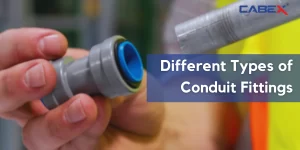Introduction
When it comes to electrical installations and wiring systems, conduit fittings play a crucial role in ensuring safety, organization, and durability. Conduit Fitting Accessories are essential components used to connect and secure electrical conduits together, providing protection for electrical cables and wires. In this comprehensive guide, we will explore the what is conduit fitting, their types, functions, and the importance of using flexible conduit accessories. So, let’s dive in and discover more about conduit fittings!
1. Understanding Conduit Fitting Accessories
1.1 Definition and Purpose of Conduit Fitting Accessories
Conduit Fitting Accessories are mechanical components used to join, connect, and secure electrical conduits together. They serve as a means to create a reliable and organized pathway for electrical cables and wires. Conduit fittings play a crucial role in protecting electrical installations from external elements, reducing the risk of damage, and ensuring the safety of the electrical system.
1.2 Types of Conduit Fittings
There are various types of conduit fittings available, each serving a specific purpose. Some common types of conduit fittings include:
- Conduit Connectors: These fittings are used to connect two different conduits together, ensuring a secure and reliable connection.
- Conduit Couplings: Couplings are used to join two conduit sections of the same size, providing a straight and continuous conduit pathway.
- Conduit Elbows: Elbows allow for changes in direction within the conduit system, typically available in different angles such as 90 degrees or 45 degrees.
- Conduit Nipples: Nipples are short sections of conduit used to extend or connect conduits in a tight space.
- Conduit Bushings: Bushings are used to protect cables from sharp edges at the entry point of the conduit system.
- Conduit Adapters: Adapters provide a transition between different conduit sizes or types, allowing for a smooth connection.
2. Common Types of Conduit Fitting Accessories
2.1 Conduit Connectors
Conduit connectors, also known as conduit couplers, are used to join two different conduits together. They are available in various configurations, such as straight connectors, reducing connectors, and offset connectors. Conduit connectors ensure a secure and reliable connection, preventing the conduits from coming apart and maintaining the integrity of the electrical system.
2.2 Conduit Couplings
Conduit couplings are used to join two sections of the same-sized conduit together, creating a straight and continuous conduit pathway. They are typically made of durable materials such as steel or PVC and are available in different lengths to accommodate various installation requirements.
2.3 Conduit Elbows
Conduit elbows allow for changes in direction within the conduit system. They are available in different angles, commonly 90 degrees and 45 degrees, and are used to navigate around corners or obstacles. Conduit elbows ensure a smooth and efficient conduit installation by minimizing the need for complex bending or routing of conduits.
2.4 Conduit Nipples
Conduit nipples are short sections of conduit used to extend or connect conduits in tight spaces. They are particularly useful when there is limited room for maneuvering or when precise adjustments are necessary. Conduit nipples provide flexibility in conduit installation, allowing for easier customization and adaptation to specific requirements.
2.5 Conduit Bushings
Conduit bushings serve a protective role by shielding cables from sharp edges at the entry point of the conduit system. They prevent the cables from being damaged or chafed when passing through the conduit opening. Conduit bushings are typically made of non-conductive materials such as plastic or rubber and are available in various sizes to match the conduit diameter.
2.6 Conduit Adapters
Conduit adapters enable the transition between different conduit sizes or types. They are essential when connecting conduits of different diameters or materials, ensuring a secure and compatible connection. Conduit adapters facilitate the integration of diverse conduit systems, allowing for flexibility and adaptability in electrical installations.
3. Functions of Conduit Fitting Accessories
3.1 Protection and Safety
One of the primary functions of conduit fittings is to provide protection and ensure the safety of electrical installations. They shield cables and wires from environmental factors such as moisture, dust, chemicals, and physical impact, reducing the risk of electrical hazards, short circuits, or equipment damage.
3.2 Cable Management
Conduit fittings play a vital role in cable management. By securely fastening and organizing electrical cables within the conduits, they help maintain a neat and orderly installation. Proper cable management reduces the chances of cable entanglement, simplifies troubleshooting, and allows for easier maintenance or future modifications.
3.3 Flexibility and Accessibility
Conduit fittings offer flexibility and accessibility in electrical installations. They enable adjustments, changes in direction, and customization to accommodate specific installation requirements. Conduit fittings provide access points for future additions or repairs, allowing for efficient expansion or maintenance of the electrical system.
4. Importance of Flexible Conduit Accessories
4.1 Definition and Advantages of Flexible Conduit
Flexible conduits are designed to provide enhanced flexibility and protection compared to rigid conduits. They are commonly made of materials such as steel, aluminum, or PVC coated with a durable, flexible covering. Flexible conduits offer advantages such as ease of installation, resistance to vibrations, and the ability to navigate complex routes or tight spaces.
4.2 Flexible Conduit Connectors
Flexible conduit connectors are specially designed fittings for connecting flexible conduits together or transitioning to rigid conduit sections. They ensure a secure connection while allowing for flexibility and movement of the conduit system. Flexible conduit connectors are available in various types, including straight connectors, 90-degree connectors, and reducing connectors.
4.3 Flexible Conduit Couplings
Flexible conduit couplings join two flexible conduits together, providing a continuous and flexible conduit pathway. They allow for movement and vibration without compromising the integrity of the electrical system. Flexible conduit couplings are available in different sizes and configurations, ensuring compatibility and ease of installation.
4.4 Flexible Conduit Elbows
Flexible conduit elbows enable changes in direction within flexible conduit systems. They are flexible and adjustable, making it easier to navigate around obstacles or tight corners. Flexible conduit elbows eliminate the need for complex bending or routing of the conduit, simplifying the installation process and improving overall flexibility.
4.5 Flexible Conduit Adapters
Flexible conduit adapters facilitate the transition between flexible conduits and rigid conduit sections or other electrical devices. They provide a secure and compatible connection, allowing for flexibility and adaptability in the conduit system. Flexible conduit adapters are available in various configurations to accommodate different sizes and types of conduits.
4.6 Flexible Conduit Glands
Flexible conduit glands are used to secure and seal the entry points of flexible conduits. They provide strain relief, preventing cables from being pulled out or damaged at the conduit’s termination point. Flexible conduit glands also offer environmental protection, keeping out dust, moisture, and other contaminants from entering the conduit system.
5. Best Practices for Using Conduit Fittings
5.1 Choosing the Right Conduit Fittings
When selecting conduit fittings, it is essential to consider factors such as the type of conduit, the environmental conditions, and the specific installation requirements. Ensure that the chosen fittings are compatible with the conduit type, adequately sized, and meet the necessary safety standards and codes.
5.2 Proper Installation Techniques
Follow proper installation techniques to ensure the effectiveness and durability of conduit fittings. Use appropriate tools and equipment, and carefully follow the manufacturer’s instructions. Properly tighten and secure the fittings to prevent looseness or disconnection over time. Pay attention to the bending radius and avoid excessive bending or straining of the conduits.
5.3 Regular Maintenance and Inspections
Regular maintenance and inspections of conduit fittings are crucial for identifying any signs of wear, damage, or deterioration. Inspect the fittings for corrosion, cracks, or loose connections. Clean and remove any debris or obstructions that may affect the functionality of the fittings. Promptly replace damaged fittings to maintain the integrity and safety of the electrical system.
Conclusion
What Is Conduit Fitting? Conduit fittings are essential components in electrical installations, providing protection, organization, and flexibility. Understanding the different types and functions of conduit fittings is crucial for ensuring the safety and reliability of electrical systems. Additionally, incorporating flexible conduit accessories further enhances the adaptability and convenience of conduit installations. By following best practices and proper installation techniques, you can create a well-designed and efficient conduit system that meets your specific needs.






